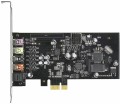Channels
The most advanced multi-channel audio format that a sound card is capable of outputting.
—
2. Standard stereo sound on two channels — left and right. This format allows you to provide a sense of surround sound (especially when using headphones), which is quite enough for most simple tasks. However, it noticeably loses to multi-channel sound in terms of the "immersion effect", which can be critical for demanding gamers and audiophiles.
—
5.1. The classic and most popular multi-channel surround sound format today: a centre channel, two front and two rear channels allow you to achieve a full-fledged “surround effect”, and a separate subwoofer channel provides rich bass sound.
—
7.1. The 7.1 format differs from 5.1 by the presence of two additional channels. There are several options for localizing these channels — for example, a pair of side speakers, a pair of additional speakers above the front ones, etc. Anyway, the 7.1 format provides a more reliable surround sound transmission than 5.1, but such cards are more expensive, and there is less specialized content for 7.1.
When choosing a sound card by the number of channels, it is worth considering such moments. Firstly, multi-channel options are capable of producing sound in simpler formats (for example, a 7.1 card can be used for 5.1 acoustics), and stereo sound output is support
...ed by all models in general. Secondly, modern multimedia software (in particular, codecs) allows you to output multi-channel audio through a card with fewer channels — for example, play 5.1 sound through a two-channel card with stereo speakers without quality loss. Thirdly, for the full-fledged operation of multi-channel sound, you will need not only a card, but also appropriate acoustics; therefore, it makes no sense to specifically look for a multi-channel model if you plan to use exclusively stereo speakers.Audiochip
Brand of the audio chip installed in the sound card.
The audio chip is one of the most important parts of a sound card, a kind of "heart" of the whole circuit, and it is on its characteristics that the sound quality and other capabilities of a particular model largely depend. Knowing the brand of the chip, you can easily find various information on it — official specifications, test results, reviews, etc. — and based on this, draw a conclusion to what extent this sound card is able to meet your requirements. Of course, for ordinary video cards (see "View") there is no need to delve into such details, but when choosing a gaming or audiophile model, they can be very useful.
Standards
Various standards and special digital audio technologies that the sound card is officially compatible with. For example, the Dolby and DTS standards in various variations are used primarily for multi-channel audio tracks in films, while DirectSound and EAX provide high-quality “surround” sound in games. In fact, the ability to work with one or another standard is largely determined by the software part of the system, and not by the characteristics of the sound card; however, official compatibility means at least the full compliance of the card with the requirements of the standard and the minimum risk of conflicts at the hardware level.
Additional power
The need to connect additional power to the sound card.
Most of both internal and external (see "Type") sound cards are powered directly through the connection connector (see "Connection interface"). At the same time, for normal operation of advanced models (for example, audiophile and gaming, as well as some DACs; see "View"), this power may not be enough, which requires an additional power source. In internal audio cards, it is carried out from the computer power supply, in external ones — directly from the 230 V network.
Signal-to-noise ratio
The signal-to-noise ratio provided by the analogue-to-digital converter (ADC) of the sound card in the processed signal. For more information about this ratio, see the paragraph of the same name above. Here we note that in domestic use it does not play a decisive role, but if you plan to record sound in good quality, you should choose a card with a high value of this indicator.
mini-Jack (3.5 mm)
The number of outputs with
3.5 mm mini-Jack connectors in the design of the sound card. It is this connector that is used by the vast majority of modern computer headphones and speakers of all price categories (although it is relatively rare in top-end technology), and it is very popular in other consumer-class audio devices. Therefore, almost all entry-level and mid-level sound cards have at least one 3.5 mm jack; the absence of such outputs is typical for specialized models (for example, DAC, see "View"). Also note that a single mini-jack output can work with a maximum of two channels, however, this interface is also used in multi-channel sound systems — in this case, the audio card is equipped with several connectors, each of which is responsible for its own part of the system. For example, for 5.1 systems, one connector is allocated to the centre, one to a pair of front channels, one to a pair of rear channels, and one to a subwoofer.
As with 3.5mm inputs (see above), this type of output can be used in a variety of ways and can even be configurable.

